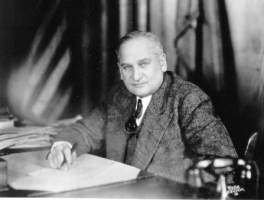William “Wild Bill” Langer was an influential member of the Nonpartisan League, and a major political figure in North Dakota for decades. He served two stints as governor, the first of which ended in his forced removal from office following two felony convictions. Langer eventually was acquitted of all charges, and would return as governor from 1937-1939. After serving his second term as governor, Langer represented at the US Senate until dying in office in 1959.
In 1934, Governor William Langer of North Dakota was charged with two felony convictions, conspiracy to extort funds from federal employees; and blocking orderly operation of an act of congress.
Seven others were originally charged, and four of them stood trial with Langer. The trial began on May 22, 1934 in Fargo, North Dakota. Twelve jurors would decide the fate of their infamous and strongly supported governor. Langer and his co-defendants entered a plea of “not guilty” and denied all charges. The defense pleaded with the court to delay the trial due to the fact that one of the prime witnesses, Assert Erickson, had been ill in the hospital for weeks.
After 60 hours of deliberation, the jury found Langer and his co-defendants guilty on June 16, with a maximum possible fine of $10,000 and sentence up to two years in prison.
Langer was sentenced to eighteen months in prison, and required to pay a fine of $10,000. Three of his co-defendants were sentenced to thirteen months in prison, with a fine of $3,000. The remaining co-defendant, Harold McDonald, was sentenced to only four months.
Following his felony convictions, the North Dakota Supreme Court ordered that Langer be removed from office and replaced by his Lieutenant Governor, Ole Olson. Langer did not go without a fight, however. He declared martial law and then called a special legislative session, where he would appear before the house and proclaim “I am still your governor.” Langer also asked for the impeachment of the members of the supreme court and Ole Olson, who had already been recognized by the United States congress as the official governor of North Dakota. Langer eventually did step down, and Olson took his place.
Langer’s wife, Lydia, ran for governor later that year, but lost. After three additional trials, Langer was eventually acquitted on all charges. After his acquittal, Langer was re-elected governor and served from 1937-1939, before moving onto represent North Dakota at the US Senate, where he died in office in 1959.



